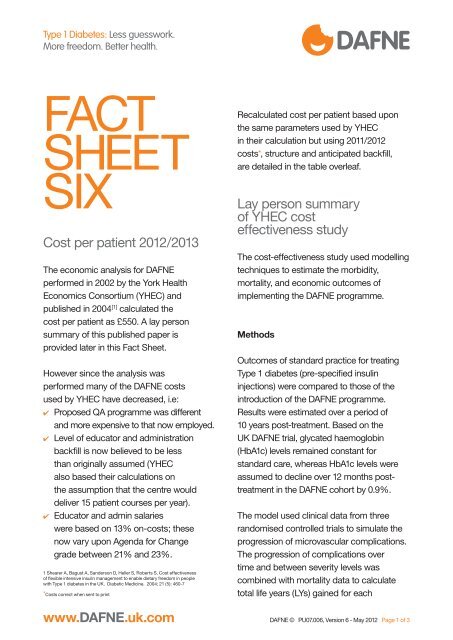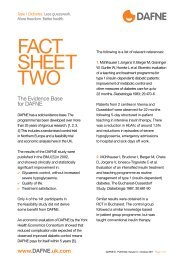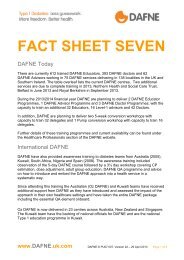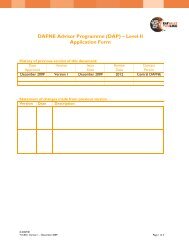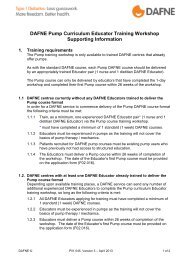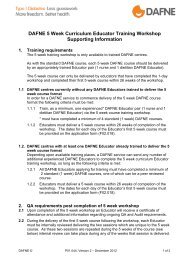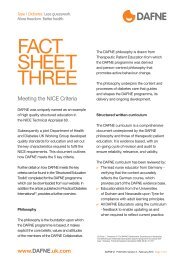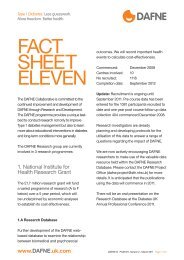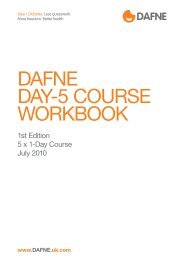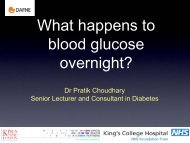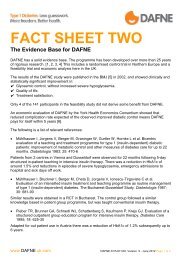FACT SHEET SIX - Dafne - UK.COM
FACT SHEET SIX - Dafne - UK.COM
FACT SHEET SIX - Dafne - UK.COM
Create successful ePaper yourself
Turn your PDF publications into a flip-book with our unique Google optimized e-Paper software.
<strong>FACT</strong><br />
<strong>SHEET</strong><br />
<strong>SIX</strong><br />
Cost per patient 2012/2013<br />
The economic analysis for DAFNE<br />
performed in 2002 by the York Health<br />
Economics Consortium (YHEC) and<br />
published in 2004 [1] calculated the<br />
cost per patient as £550. A lay person<br />
summary of this published paper is<br />
provided later in this Fact Sheet.<br />
However since the analysis was<br />
performed many of the DAFNE costs<br />
used by YHEC have decreased, i.e:<br />
✔✔<br />
Proposed QA programme was different<br />
and more expensive to that now employed.<br />
✔✔<br />
Level of educator and administration<br />
backfill is now believed to be less<br />
than originally assumed (YHEC<br />
also based their calculations on<br />
the assumption that the centre would<br />
deliver 15 patient courses per year).<br />
✔✔<br />
Educator and admin salaries<br />
were based on 13% on-costs; these<br />
now vary upon Agenda for Change<br />
grade between 21% and 23%.<br />
1 Shearer A, Bagust A, Sanderson D, Heller S, Roberts S. Cost effectiveness<br />
of flexible intensive insulin management to enable dietary freedom in people<br />
with Type 1 diabetes in the <strong>UK</strong>. Diabetic Medicine. 2004; 21 (5): 460-7<br />
*Costs correct when sent to print<br />
Recalculated cost per patient based upon<br />
the same parameters used by YHEC<br />
in their calculation but using 2011/2012<br />
costs*, structure and anticipated backfill,<br />
are detailed in the table overleaf.<br />
Lay person summary<br />
of YHEC cost<br />
effectiveness study<br />
The cost-effectiveness study used modelling<br />
techniques to estimate the morbidity,<br />
mortality, and economic outcomes of<br />
implementing the DAFNE programme.<br />
Methods<br />
Outcomes of standard practice for treating<br />
Type 1 diabetes (pre-specified insulin<br />
injections) were compared to those of the<br />
introduction of the DAFNE programme.<br />
Results were estimated over a period of<br />
10 years post-treatment. Based on the<br />
<strong>UK</strong> DAFNE trial, glycated haemoglobin<br />
(HbA1c) levels remained constant for<br />
standard care, whereas HbA1c levels were<br />
assumed to decline over 12 months posttreatment<br />
in the DAFNE cohort by 0.9%.<br />
The model used clinical data from three<br />
randomised controlled trials to simulate the<br />
progression of microvascular complications.<br />
The progression of complications over<br />
time and between severity levels was<br />
combined with mortality data to calculate<br />
total life years (LYs) gained for each<br />
www.DAFNE.uk.com<br />
DAFNE © PU07.006, Version 6 - May 2012 Page 1 of 3
Cost for<br />
6 courses<br />
per year<br />
Cost for<br />
12 courses<br />
per year<br />
Cost for<br />
15 courses<br />
per year<br />
Educator backfill @ 10 days per<br />
course based on AfC top band 7 incl.<br />
22.3% on-costs<br />
A&C backfill @ 3 days per course<br />
based on AfC top band 3 incl.<br />
22% on-costs<br />
£11,333.40 £22,666.80 £28,333.50<br />
£1,611.36 £3,222.72 £4,028.14<br />
Patient resources @ £4.82/patient £231.36 £462.72 £578.40<br />
Training 2 x Educators and 1 x Dr -<br />
10% depletion of staff per year<br />
DAFNE set up costs -<br />
10% depletion per year<br />
£300.00 £300.00 £300.00<br />
£110.40 £110.40 £110.40<br />
Central Administration contribution £3,650.00 £3,650.00 £3,650.00<br />
Total £17,236.52 £30,412.64 £37,000.70<br />
Number of patients 48 96 120<br />
Cost per patient £359.09 £316.80 £308.34<br />
* Note: Costs correct when sent to print and are subject to change.<br />
patient cohort. Quality of life weights<br />
were also combined with LYs to estimate<br />
quality-adjusted life years (QALYs)<br />
associated standard care and DAFNE.<br />
NHS costs associated with standard<br />
care or DAFNE, and with the treatment of<br />
progressing complications were used to<br />
estimate a total cost for patients in each<br />
cohort over the 10 years of the model.<br />
Results<br />
Costs: The DAFNE cohort was estimated<br />
to have reductions in mortality, blindness,<br />
end stage renal disease, foot ulceration/<br />
amputation, and episodes of ketoacidosis,<br />
as compared with standard care. These<br />
reductions in complications resulted in a<br />
mean saving of £3238 per patient over 10<br />
years. The majority of cost savings occurred<br />
from avoiding foot ulcers and renal dialysis.<br />
The cost savings as a result of reduced<br />
complications were partly offset by the cost<br />
of delivering the DAFNE programme (mean<br />
cost per patient over 10 years = £545) and<br />
the more frequent insulin injections required<br />
in the DAFNE cohort than in standard care<br />
(mean cost per patient over 10 years = £456).<br />
Overall, it was estimated that the DAFNE<br />
programme would save the NHS £2,237 per<br />
patient over 10 years and would break even<br />
at approximately 4.5 years post intervention.<br />
DAFNE © PU07.006, Version 6 - May 2012 Page 2 of 3
Cost-effectiveness: For the 10 years<br />
included in the model, DAFNE produces<br />
an additional 5 life years, 12 QALYs, or 9<br />
QALYs for every 100 patients treated in<br />
comparison with the standard care. Given<br />
that DAFNE is more effective and less costly<br />
than standard care it is clearly cost-effective.<br />
For the latest information about DAFNE<br />
please check the website or email:<br />
dafne@northumbria-healthcare.nhs.uk<br />
www.DAFNE.uk.com<br />
twitter.com/DAFNE<strong>UK</strong><br />
facebook.com/<strong>UK</strong>DAFNE<br />
Conclusions and Impact<br />
The results of this cost-effectiveness<br />
modelling study suggest that for an NHS<br />
centre implementing the DAFNE programme<br />
cost savings arising from a reduction in<br />
microvascular complications would outweigh<br />
the additional costs of providing the<br />
programme after approximately 4.5 years. In<br />
the long run, DAFNE could be a cost saving<br />
intervention for a provider to implement,<br />
whilst also yielding additional mortality and<br />
morbidity benefits over and above standard<br />
diabetic care. Further incentives for providing<br />
the DAFNE programme include its alignment<br />
with the National Service Framework for<br />
Diabetes and with the NICE guidance for the<br />
use of patient education in diabetes care.<br />
DAFNE Online is an independent community of<br />
DAFNE Graduates, Health Care Professionals,<br />
Management and friends and family of those<br />
with Type 1 diabetes. Please visit the website to<br />
find out more.<br />
www.DAFNEonline.co.uk<br />
DAFNE © PU07.006, Version 6 - May 2012 Page 3 of 3


